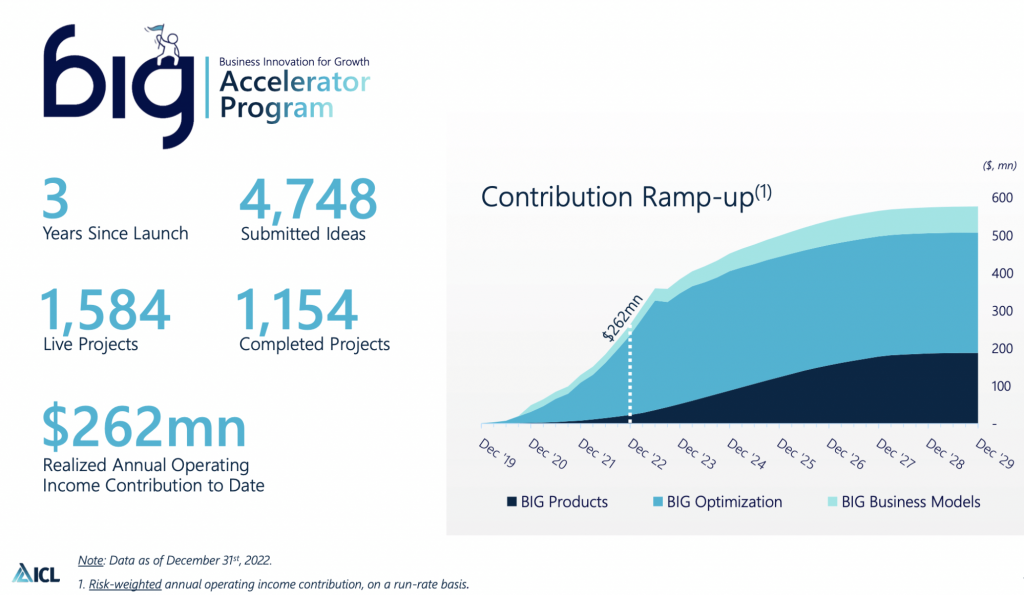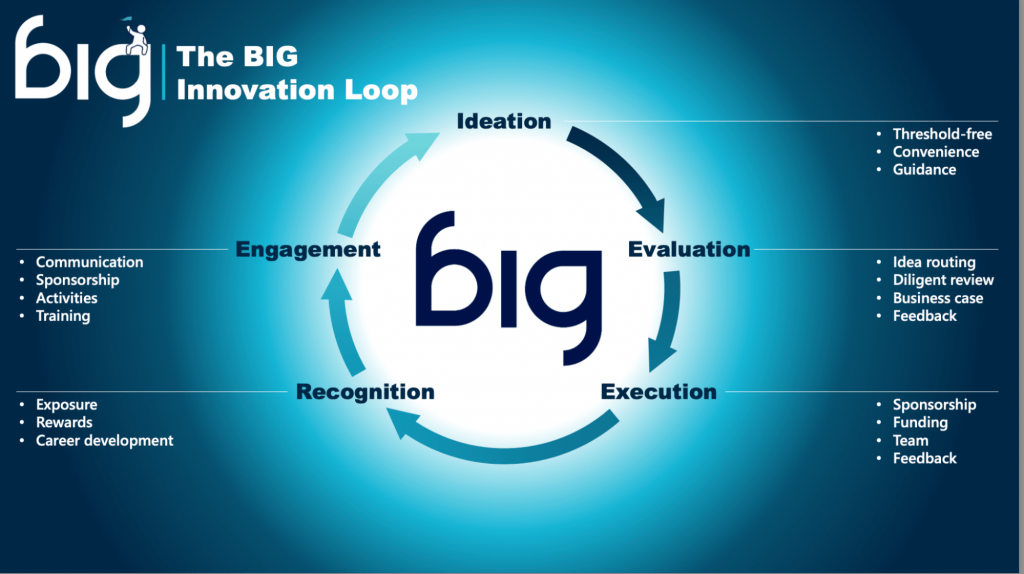“If enough people share the same vision, it becomes a reality.”
Eduard Croitoru, VP of ICL Corporate Initiatives.
The innate human capacity for innovation has driven our development since the earliest times. We’re now experiencing a new technological revolution that is already transforming the world beyond recognition. Companies that identify innovation as a key driving force, and actively channel an innovative spirit, will be industry leaders over the next decade – and beyond.
Many companies (and other organizations) just pay lip service to the concept of innovation. They understand innovation as an abstract concept but fail to create a genuinely innovative corporate culture that consistently delivers an improvement to operational processes, including both efficiencies and sustainability, product enhancements as well as novel technologies, and finally new business models.
Innovation is vital for continuous growth, but the problem of how to structure an innovation process and measure innovation performance is a stumbling block for many businesses.
ICL Group is an international enterprise that grew from small pioneering ventures in Israel’s harsh desert region over a hundred years ago. Innovation is embedded in ICL’s corporate DNA and is central to its dynamic global expansion. ICL has positioned itself as a market leader in the fields of AgTech innovation and FoodTech innovation. Its new $400 million LFP plant in St.Louis will place the group at the heart of the global energy storage and electric vehicles industries.
Eduard Croitoru – VP of ICL Corporate Initiatives, offers valuable insight into one of the world’s leading internal innovation programs. He joined us today to explain the thinking behind the BIG Program, the reasons for its exponential success during recent years, and his vision for a truly innovative future.
Welcome Eduard! How would you define Innovation?
To me, effective innovation means generating and executing new people-driven initiatives, which change what we are used to doing to what we should be doing, in order to create a meaningful positive impact on our business – for our company as well as for all of our stakeholders.
What are the challenges of corporate innovation?
Wow, that’s a big topic that people write whole books about. I’ll try to address it as succinctly as I can and summarize the key points of the BIG Program philosophy.
Many companies have certain innovation efforts, mostly conducted in silos. That means that there’s limited global connectivity and limited inter-divisional communication and collaboration. The typical workplace initiatives program tends to be mainly focused on the ongoing development of the existing portfolio development rather than on building the future pipeline through structured ideation, execution, and monitoring processes.
When we encourage innovative initiatives we need to be aware of common ideation barriers like:
- Restrictive mindset driven by the “Not Invented Here” syndrome.
- Obsolete budget flexibility issues that cripple dynamic innovation.
- A corporate culture that produces mid-management barriers (blocking employees from expressing themselves, or communicating freely with senior management).
- The idea that Innovation is nice to have, but not a top priority.
Even if you have the mindset for innovation within a company, you still need to establish powerful enablers before you can attempt any people-driven innovation programs. Startups may have a modern and forward-thinking culture but usually lack the ability to innovate at scale and therefore must focus their efforts on a rather narrow path.
Enterprises, on the other hand, have the bandwidth to execute a large variety of initiatives, yet sometimes lack the critical enablers to do so efficiently and consistently. Key issues that the BIG program seeks to address are:
- A dedicated and accessible platform for global employee engagement.
- Structured processes and robust human infrastructure for idea evaluation and execution support.
- Enhanced employee empowerment, enablement, and above all – recognition. If you wish to encourage innovation initiatives, at scale, you need a systematic way to motivate, facilitate and reward the original thinking that creates them, as well as the efforts put into evaluating and executing them.
We also focus on defining performance measurements for innovation projects. The lack of ability to measure performance (plus limited central view and control) hampers many worthwhile projects. It’s vital to ensure that there’s always routine visibility into execution progress and key project metrics, as well as unlimited access to “factory floor level” ideas.
Another major challenge that I want to highlight is that of an underdeveloped innovation culture in a company. This is often an inherited problem that results from a long-term failure to modernize. It has to be addressed from the top down i.e. starting with the Board and the CEO. VPs also have a huge role to play in changing an underdeveloped innovation culture. Symptoms/problems include:
- Paying lip service to the concept of innovation without a clear understanding or commitment to the concept.
- Limited employee engagement and education.
- Limited employee recognition and reward.
- Vague accountability for innovation performance.
Some of the points I’ve mentioned overlap and are interconnected. The key point that many businesses need to focus on is probably how to measure innovation performance effectively. Innovation is part of our human makeup and it flourishes with even the slightest encouragement. The real challenge is how to quantify and optimize the results and channel them in a strategic direction for growth.
What are the key objectives of the ICL BIG Program?
The key objectives of the program are threefold. We keep our objectives simple, clear, and (as much as possible) quantifiable.
- Enhance ideation
- Accelerate execution
- Improve collaboration
What are the Basics of BIG?
Again, we believe in keeping things simple and straightforward. Experience taught us that there are a few key basics that can be applied to every company and scenario and we stick with them.
We always start by defining what we mean by innovation, which works to set the ground rules. Then we establish our communication channels and build an infrastructure that supports idea evaluation and execution. We also decide how to measure innovation performance with a uniform measurement system.
Perhaps where BIG differs from similar concepts is that we managed to create a fully structured process that ensures continuous engagement by both employees and management. By establishing a broad human network, we are able to leverage the collective ingenuity of our people, monitor idea processing and project execution and provide impactful recognition.
We aim to acknowledge and reward creativity and effort – as well as actual results. It’s the (holistic) innovative mindset and flow that we successfully established and are working very hard to preserve for the long run.
Finally, to establish such a large-scale operation and to maintain its momentum for the long term, the program must continuously evolve. Others would probably phrase this as agility. When we started, we had a specific and focused structure and operational plan for launching the program. Ever since we launched, we are methodically monitoring the impact of every activity, structural design, routine, or formula that we employ, all while ensuring divisional and unit-level BIG activities and decision-making processes are independent, so that the corporate BIG process serves as a complementary and supportive process, rather than an obstructing or conflicting one.
Breaking down the program into smaller components, or building blocks if you want, and monitoring the value and impact of each of them based on observable data, is what allows us to make frequent changes and adaptations.
This agile approach, together with the empowerment of divisional and unit-level networks, results in the continuous expansion, enhancement, and optimization of the program while maintaining a very lean structure. These two structural and operational pillars, allow the program to deliver the consistent results we are seeing and maintain the engagement momentum by both employees and management.
How has the BIG Program been successful in driving growth for ICL?
Innovation drives growth! Our people have been really successful at it, and because of our methodology, we have the statistics to prove it! As of December 2022, we had an astonishing 4,748 submitted ideas that were so far converted into over 1,500 projects. These figures alone demonstrate the massive employee engagement and tremendous impact. With hundreds of ideas still under evaluation and an average of almost 400 ideas submitted every quarter, the future of ICL is truly BIG.

These 4,738 ideas generated 1,584 live projects of which 1,154 were successfully completed. I’m really proud of these numbers, although the problem with numbers is that they can never adequately portray the human endeavor and commitment involved, or what it means for the business to have completed 1,154 successful projects that probably wouldn’t have existed without BIG.
The fiscal results are equally encouraging. We measured a realized Annual Operating Income Contribution to Date of $262 million, with an anticipated final (risk-weighted) outcome in excess of $577 million. Yearly operating Income contribution increased every quarter due to the new projects. These are fantastic figures that vindicate the creation of the BIG Project and make the future a very exciting place!
What strategies have you found to be most effective in achieving the goals of the program?
My CPA background helped me to understand that in order for innovation to succeed and flourish, it needs to be treated the same as financial results. ICL meets quarterly to review financial results, just as we do with innovation. This systematic approach, with transparent innovation performance measurement, or ‘innovation accounting’, has been one of the key drivers for the success of BIG.
What is unique about BIG?
Three things (apart from the amazing people who make it all happen) are unique about BIG:
- The measurement system.
- Persistence and endurance: The BIG Project has been running for over 3 years and has not lost momentum.
- The sheer scale and magnitude of the program, as well as the breadth of its vision.
How does ICL measure the success of the program?
Another big question! I’ll answer as briefly as I can and try to summarize our methodology. To measure progress, we created the BIG Index.
The BIG index is a simplified measurement method that allows us to routinely monitor our ideation and execution performance, set effective goals, and promote and facilitate healthy competition.
- We went from an absolute value to an Index– BIG is not concerned about the absolute number, our focus on the program is not about the starting point, end point, volume, or the total BIG Score. It is about the change on the BIG Index, that clearly tells us if we are going forward towards meeting our targets or not.
- We avoid complex values and prefer targets (rather than complex projections such as NPVs). These targets can easily be updated to facilitate routine monitoring.
- This uniform measuring system allows us to focus on progress, and to compare different units. That creates the basis for corporate and unit-level KPIs to ensure we are meeting our targets. It also helps create healthy and positive competition between units. Everyone wants to take the lead!
- We focus on portfolio management and not project management.
- The business units are always at the center of the project, R&D supports the BU’s, but the BU implements the technologies, optimization, or production systems. We always remember that it’s the BU that produces and generates profits.
Where do you get the Ideas that make BIG so Successful?
“We get ideas from employees from all around the globe via our internal ideation platform PITCH BIG. We opened this online platform where people can submit their ideas 24/7, which are then routed for evaluation by our network of BIG Champions, BIG Captains, and BIG Experts, and potentially get converted into live projects. Using this convenient tool, tailored to fit the program’s methodology, we are able to build a continuous flow of ideas and a broad and robust pipeline of innovative projects.
Each new project takes on its own momentum and adds more BIG Index with each phase of development and change of its core estimates. Everything is measurable and there are many ways to increase your BIG Index but it is mostly by taking ideas, converting them into projects, and completing them with minimal delays. Employee credit, recognition, and exposure are core to the success of BIG. Combined with timely and diligent idea reviews and feedback to idea submitters, these encourage even more ideas to be submitted to the platform.
The BIG Innovation Loop
The BIG Innovation Loop demonstrates the flow of five core concepts that drive and enable innovation in the workplace. It also shows the factors, milestones, and benefits that accompany each stage of the BIG innovative process. Ensuring that every stage of this loop is diligently managed and optimized, for every idea and project, is what led us to maintain the momentum and high engagement levels for over 3 years now. Establishing the structure and processes to create this loop is rather difficult, but once you’re in the loop and you are managing all of its stages properly, corporate innovation becomes easy!

What lessons have you learned from the program that you can share with others?
If there’s a key lesson, it’s that an emphasis on innovation is just wishful thinking without an effective and uniform innovation performance measurement. You need to identify and eliminate all the hindering factors that I mentioned above. These factors result in a huge underutilized innovation potential. Everybody means well, but if you can’t quantify innovation you cannot really progress. We need to understand individual and collective levels of responsibility and accountability for innovation.
There are companies with an innovative spirit and original thinkers and natural problem solvers in their teams. These businesses are genuinely trying to promote innovation initiatives, but they cannot achieve their full potential unless they tackle these inherited limiting factors.
This is exactly what we set out to unlock at ICL and we did it. BIG is about changing what we used to do for what we need to do to create a positive impact. Innovation is for every employee, no matter how junior or new to the job. I’ll finish with one of my favorite quotes.
“If you think you are too small to make a difference, try sleeping with a mosquito.”
Dalai Lama
More on the subject:
ICL Planet Startup Leaps Forward
Meet ICL’s Open Innovation Landscape and Initiatives
Innovation Starts from Within
ICL – Focused Innovation for a Better Future
ICL is committed to innovation as a game-changing force. Whether it’s through Innovative materials that transform industrial products, new phosphate recycling methods, advanced lithium battery technologies, next-generation plant nutrition products, or any of the ideas coming through our internal BIG Business Innovation Accelerator Program, we’re investing in innovation for a better world.
Innovation is the single force that can bridge the gap between obsolete 20th-century business and manufacturing processes and a new sustainable model. We not only reward innovation within our own global divisions but also welcome partnerships and collaboration with committed innovators who have original concepts in the fields of food tech and crop nutrition.








